The origin of thermoacoustics. Singing flame of Higgins. Riyke tube
Thermoacoustic effect was discovered by glass blowers several centuries ago. When glass-blowers blew a glass ball heated to a high temperature and located at the end of the tube, a monotonous sound appeared spontaneously from the open end of the tube. The first scientific work in this direction held Higgins in 1777.
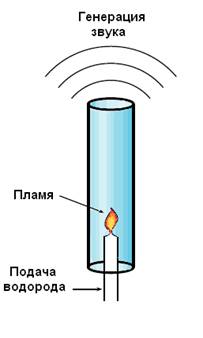
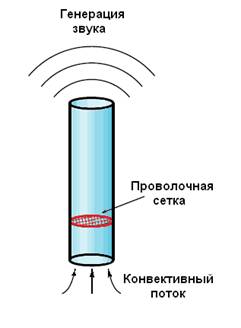
Fig. 1. The singing Higgins flame on the left and the Rijke tube on the right
He created a slightly different device than the glassblowers, namely the “singing flame,” placing the flame of a hydrogen torch approximately in the middle of a metal pipe open at both ends. Later in 1859, Paul Rijke continued these experiments. He replaced the flame on a heated metal mesh. He moved the grid inside the vertically positioned pipe and found that when the grid was placed 1/4 of the length of the pipe from the lower end, the maximum volume was observed.
You can see how this looks in this video:
When watching a video, you can see several important details that suggest the principles of operation of the Rijke tube. It can be seen that while the burner heats the grid in the tube, no oscillation is observed. Fluctuations begin only after Valerian Ivanovich removes the burner to the side. That is, it is important that the air under the grid was colder than above the grid. The next important point is that the oscillations stop if you rotate the tube horizontally. That is, for the occurrence of oscillations, upward convective air flow is needed.
How does the air hover in the tube?
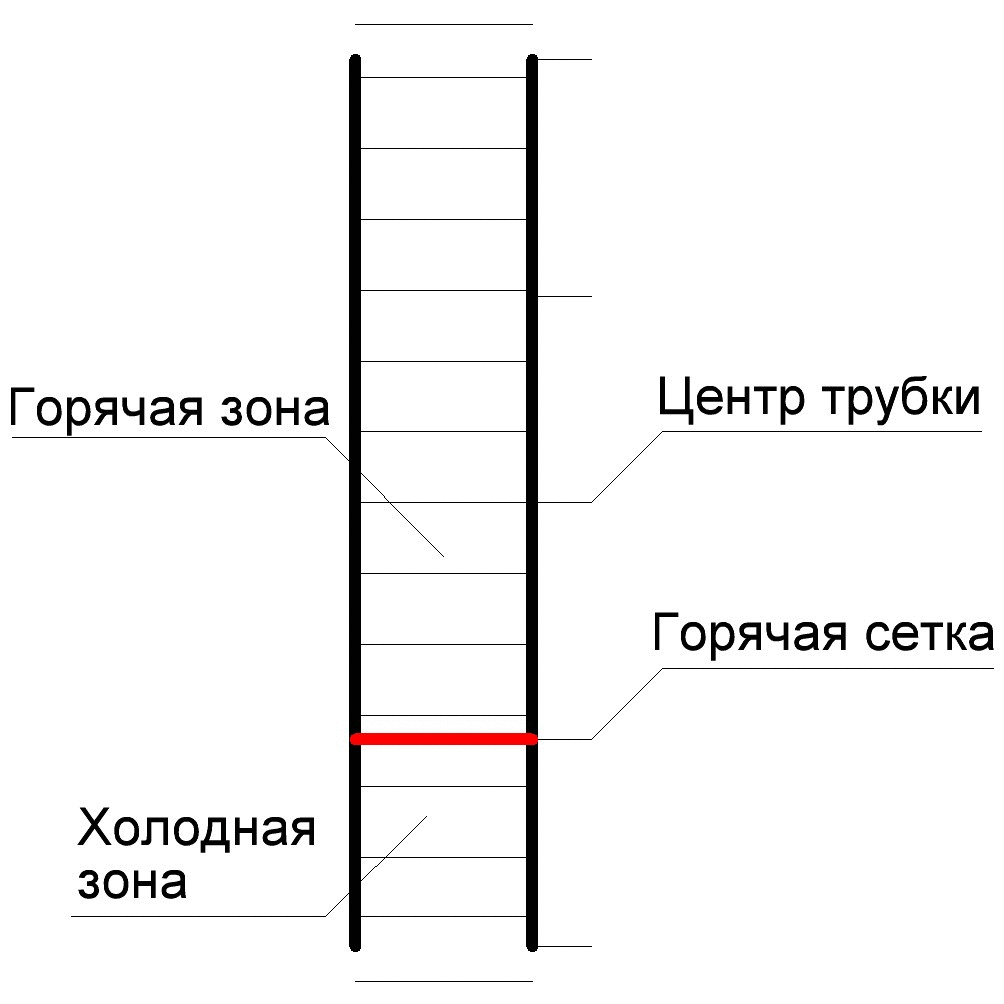
GIF 1. The acoustic component of the movement of air
. GIF-1 shows the movement of air in a tube due to the presence of an acoustic wave. Each of the lines represents the movement of a conditionally separated thin layer of air. It can be seen that in the center of the tube the value of the vibrational velocity of air is zero, and on the edges of the tube, on the contrary, is maximum.
The pressure oscillations are opposite, maximal in the center of the tube and close to zero along the edges of the tube, since the ends of the tube are open and there is atmospheric pressure, and pressure fluctuations are possible in the center, since there is no place for air to escape.
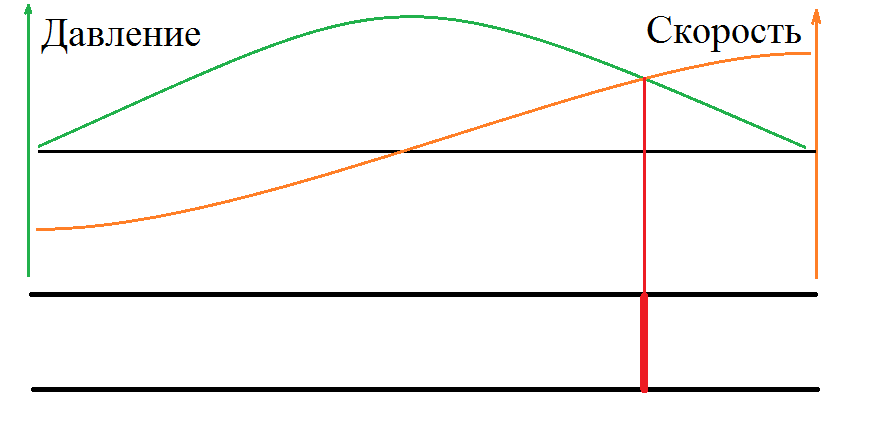
Fig. 2. The pressure distribution in the maximum pressure point in the center of the tube and the distribution of vibrational velocity when the maximum velocity at the ends of the tube
thus unambiguously can be said that the acoustic wave, which occurs in the Rijke tube is standing, with a pressure node at the edges of the tube and hub oscillatory velocity in the middle. The length of the tube is half the length of the acoustic wave. This means that the tube is a half-wave resonator. Pay attention to fig. 2. It is shown that the optimal position of the hot grid in the tube is in the place where the product of pressure and velocity is maximal. This place is approximately 1/4 the length of the tube from the lower end. That is, for the process, the presence of both velocity oscillations and pressure oscillations is important.
For the occurrence of oscillations, as it turned out from the video, you need not only a resonator, but also a continuous stream of air directed upward of the tube. That is, here is the movement of air:

Gifka 2. Convective air flow
When the tube is in a vertical position, a constant air flow arises due to the fact that the air heated by the mesh rises up. Convective flow occurs.
Air oscillations and convective flow in reality exist simultaneously. These two processes overlap each other, and it turns out about the following movement:
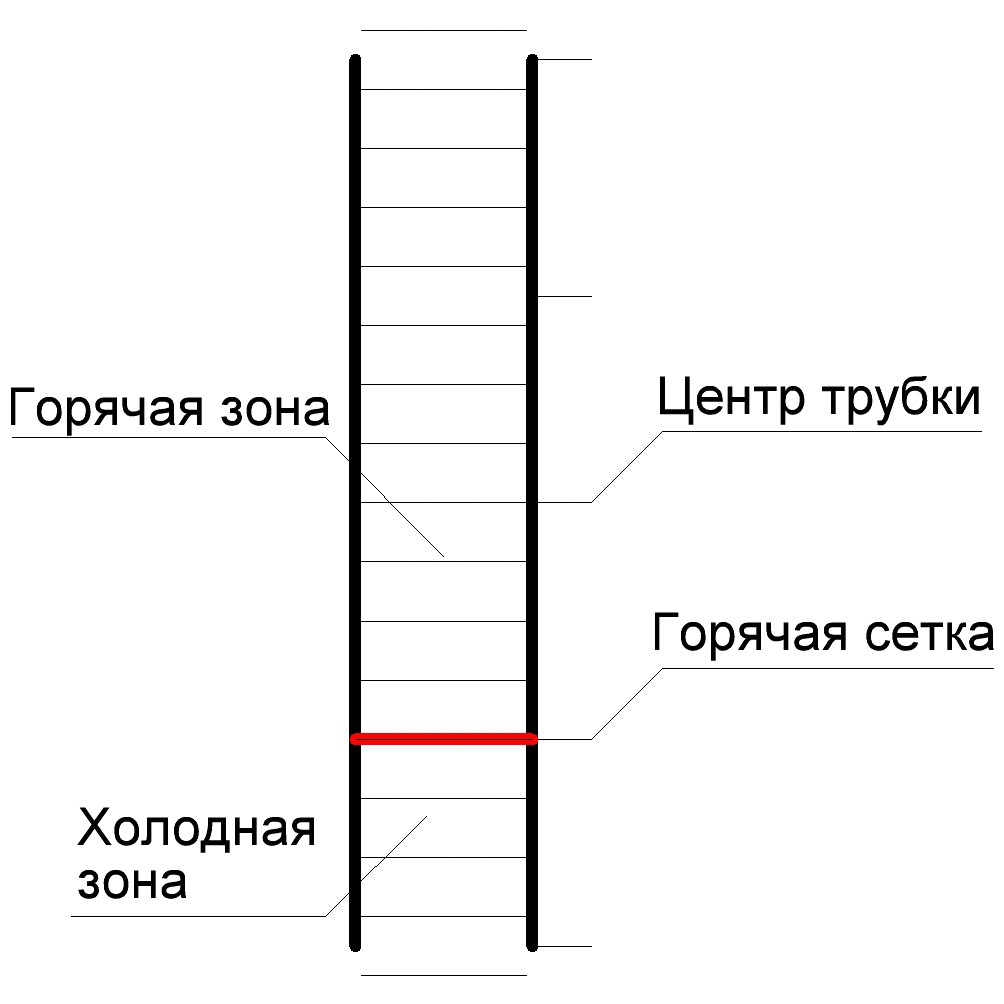
Gifka 3. The combined movement of air - fluctuations + convective flow The
movement of air described. Now you need to understand how the acoustic wave arises and is maintained in the tube.
The Rijke tube is a self-oscillatory system in which the attenuation mechanisms of an acoustic wave are naturally present. Therefore, to maintain the wave, it is necessary to continuously feed it with energy in each oscillation period. To better understand how the wave is energized by energy, consider hypha 3.
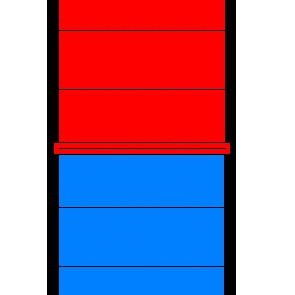
Gifka 3. Thermodynamic cycle in a tube. The
movement of air is very similar to the movement of a caterpillar that crawls up the tube.
On gifka 3. presents the ideal case in which the effect is maximum. Consider it in more detail. It is seen that the air in this tracked its movement is compressed in the cold zone under the heated grid, and then expands already in the hot, passing through the grid. Thus, when expanding, the air takes energy from the heated grid and it gradually cools. A thermodynamic cycle is implemented with positive gas work. Due to this, the initial infinitely small oscillations are amplified, and when the power of the wave feed becomes equal to the power of the wave attenuation, a balance occurs, and we begin to hear a constant, monotonous sound.
Such an ideal case is realized only with a certain speed of a convective flow and with a certain temperature of the grid. In most practical cases, the movement of air in the grid zone is slightly different, but this only worsens the efficiency of the tube, but does not change the principle of operation.
After the principle of operation of the Rijke tube became clear, the question immediately arises: why then does the Higgins flame sing most strongly when placed in the center of the tube? The thing is that the flame is much stronger than the grid warms the air beneath and therefore the optimum point for its location is higher than that of the grid. So whether it is necessary to place the flame in the center of the tube, or closer to the lower end, essentially depends on the flame and on the length of the tube.


Fig. 1. The singing Higgins flame on the left and the Rijke tube on the right
He created a slightly different device than the glassblowers, namely the “singing flame,” placing the flame of a hydrogen torch approximately in the middle of a metal pipe open at both ends. Later in 1859, Paul Rijke continued these experiments. He replaced the flame on a heated metal mesh. He moved the grid inside the vertically positioned pipe and found that when the grid was placed 1/4 of the length of the pipe from the lower end, the maximum volume was observed.
You can see how this looks in this video:
What is the working principle of the Rijke tube?
When watching a video, you can see several important details that suggest the principles of operation of the Rijke tube. It can be seen that while the burner heats the grid in the tube, no oscillation is observed. Fluctuations begin only after Valerian Ivanovich removes the burner to the side. That is, it is important that the air under the grid was colder than above the grid. The next important point is that the oscillations stop if you rotate the tube horizontally. That is, for the occurrence of oscillations, upward convective air flow is needed.
How does the air hover in the tube?

GIF 1. The acoustic component of the movement of air
. GIF-1 shows the movement of air in a tube due to the presence of an acoustic wave. Each of the lines represents the movement of a conditionally separated thin layer of air. It can be seen that in the center of the tube the value of the vibrational velocity of air is zero, and on the edges of the tube, on the contrary, is maximum.
The pressure oscillations are opposite, maximal in the center of the tube and close to zero along the edges of the tube, since the ends of the tube are open and there is atmospheric pressure, and pressure fluctuations are possible in the center, since there is no place for air to escape.

Fig. 2. The pressure distribution in the maximum pressure point in the center of the tube and the distribution of vibrational velocity when the maximum velocity at the ends of the tube
thus unambiguously can be said that the acoustic wave, which occurs in the Rijke tube is standing, with a pressure node at the edges of the tube and hub oscillatory velocity in the middle. The length of the tube is half the length of the acoustic wave. This means that the tube is a half-wave resonator. Pay attention to fig. 2. It is shown that the optimal position of the hot grid in the tube is in the place where the product of pressure and velocity is maximal. This place is approximately 1/4 the length of the tube from the lower end. That is, for the process, the presence of both velocity oscillations and pressure oscillations is important.
For the occurrence of oscillations, as it turned out from the video, you need not only a resonator, but also a continuous stream of air directed upward of the tube. That is, here is the movement of air:

Gifka 2. Convective air flow
When the tube is in a vertical position, a constant air flow arises due to the fact that the air heated by the mesh rises up. Convective flow occurs.
Air oscillations and convective flow in reality exist simultaneously. These two processes overlap each other, and it turns out about the following movement:

Gifka 3. The combined movement of air - fluctuations + convective flow The
movement of air described. Now you need to understand how the acoustic wave arises and is maintained in the tube.
The Rijke tube is a self-oscillatory system in which the attenuation mechanisms of an acoustic wave are naturally present. Therefore, to maintain the wave, it is necessary to continuously feed it with energy in each oscillation period. To better understand how the wave is energized by energy, consider hypha 3.

Gifka 3. Thermodynamic cycle in a tube. The
movement of air is very similar to the movement of a caterpillar that crawls up the tube.
On gifka 3. presents the ideal case in which the effect is maximum. Consider it in more detail. It is seen that the air in this tracked its movement is compressed in the cold zone under the heated grid, and then expands already in the hot, passing through the grid. Thus, when expanding, the air takes energy from the heated grid and it gradually cools. A thermodynamic cycle is implemented with positive gas work. Due to this, the initial infinitely small oscillations are amplified, and when the power of the wave feed becomes equal to the power of the wave attenuation, a balance occurs, and we begin to hear a constant, monotonous sound.
Such an ideal case is realized only with a certain speed of a convective flow and with a certain temperature of the grid. In most practical cases, the movement of air in the grid zone is slightly different, but this only worsens the efficiency of the tube, but does not change the principle of operation.
After the principle of operation of the Rijke tube became clear, the question immediately arises: why then does the Higgins flame sing most strongly when placed in the center of the tube? The thing is that the flame is much stronger than the grid warms the air beneath and therefore the optimum point for its location is higher than that of the grid. So whether it is necessary to place the flame in the center of the tube, or closer to the lower end, essentially depends on the flame and on the length of the tube.
